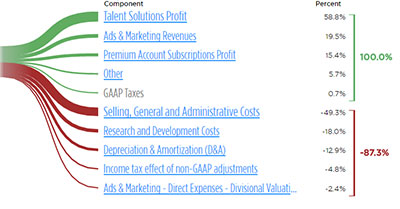

Hiring and recruiter tools still account for the overwhelming majority of sales in the firm's largest segment, which increased 45% during the company's FY 2015. Most visibly, it revamped the company's core mobile app.įor its Talent Solutions segment, LinkedIn overhauled its leading Recruiter product for the first time in 7 years. In order to do this, the company recommitted to helping members "stay connected and informed, advance their careers, and work smarter."To further this aim, LinkedIn initiated a number of key business and product changes last year that should bear fruit in 2016 and beyond. Last year, LinkedIn refocused its long-term strategy "around the principle of creating greater value for our members and our customers, connecting them to opportunity." Thankfully, the firm forced through several important product improvements in 2015 that should help support its long-term profitability going forward. The company should finally flip to full-time profitability in its current FY 2016, though its long history of GAAP unprofitability despite outsized growth is certainly worth noting. However, to the benefit of investors here and now, its newfound trading levels also make LinkedIn one of the more interesting growth stocks on the market today.ĭon't call it a comeback While not tantalizingly cheap, LinkedIn's stock arguably presents one of the most compelling opportunities in all of tech today. Even relatively new growth investors should be able to see how this one-two punch of negativity could trigger a massive sell-off in LinkedIn stock. Understandably, alarm bells sounded among many growth investors who focused on the news of slowing growth for what has historically been a richly valued stock.

Analysts had expected EPS of $3.65 on sales of $3.9 billion. Specifically, LinkedIn said it anticipates earnings between $3.05 and $3.20 on a per share basis, with revenues coming in between $3.6 billion and $3.65 billion.

The firm partially missed analyst estimates and issued FY 2016 guidance well below analysts' mean estimates. LinkedIn shares have lost nearly a quarter of their value in the last three months.Though this may sound like short-termism, LinkedIn violated a cardinal rule for growth stocks. “Given those macro concerns and LinkedIn’s recent execution issues, we expect investors will demand financial outperformance before there is meaningful recovery in LNKD’s multiple,” Goldman Sachs analysts wrote in a client note. LinkedIn has been spending heavily on expansion by buying companies, hiring sales personnel and growing outside the United States, but is now facing pressure in Europe, the Middle East, Africa and Asia-Pacific due to macro-economic issues. Facebook, Alphabet and Inc are better picks for investors than LinkedIn, Evercore analysts wrote. LinkedIn should be trading at $71.79, a 35% discount to the stock’s Friday’s low of $75.54, according to StarMine’s Intrinsic Valuation model, which takes analysts’ five-year estimates and models the growth trajectory over a longer period. “We were wrong,” they said in a client note.Īs of Thursday, LinkedIn shares were trading at 50 times forward 12-month earnings versus Twitter’s 29.5 times, Facebook’s 33.8 and Alphabet’s 20.9, making it one of the most expensive stocks in the tech sector.Įven after the selloff, LinkedIn’s shares may still be overvalued, according to Thomson Reuters StarMine data. RBC analysts said they had thought LinkedIn was on the cusp of “fundamentally positive” change. Underscoring the slowdown in growth, LinkedIn said online ad revenue growth slowed to 20% in the fourth quarter from 56% a year earlier. “This would imply that LinkedIn will grow around 15% in 2017 and 10% in 2018,” the Mizuho analysts said. LinkedIn forecast full-year revenue of $3.60-$3.65bn, missing the average analyst estimate of $3.91bn, according to Thomson Reuters I/B/E/S. At least 22 brokerages cut their price targets on the stock, with RBC slashing its target by almost half to $156. Raymond James, Cowen and Co, BMO Capital Markets, JP Morgan Securities, RBC Capital Markets and Suntrust Robinson also downgraded the stock. Mizuho downgraded the stock to “neutral” and slashed its target price to $150 from $258. “With a lower growth profile, we believe that LinkedIn should not enjoy the premium multiple it has grown accustomed to,” Mizuho Securities USA Inc analysts wrote in a note.


 0 kommentar(er)
0 kommentar(er)
